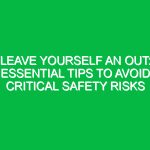“`html
Must-Know Leg Safety Guidelines: Avoid These Critical Risks Today!
Introduction
Good morning team! Today, we’re going to focus on a vital aspect of our Workplace Safety: leg safety. It’s essential to understand the risks associated with our daily tasks and how we can prevent injuries. Leg injuries can lead to severe consequences not just for your health, but also for our productivity and overall workplace morale. Let’s dive into the must-know leg safety guidelines to keep ourselves safe!
Understanding Leg Safety Guidelines
Leg safety refers to the set of practices and Precautions we must follow to protect our legs from injuries while performing various tasks. It’s crucial because our legs play a significant role in nearly every aspect of our work, from standing and walking to lifting and moving. Ignoring leg safety can lead to sprains, fractures, or even long-term disabilities.
Many employees believe that leg injuries only happen in high-risk environments, but the reality is that they can occur anywhere—whether you’re in a factory, office, or on a construction site. Understanding this can help us take proactive measures to stay safe.
Key Hazards, Risks, and Safety Considerations
Let’s discuss some specific hazards and risks associated with leg safety:
- Slips, Trips, and Falls: One of the most common causes of leg injuries. Uneven surfaces, spills, or clutter can lead to accidents.
- Heavy Lifting: Improper lifting techniques can result in strains or injuries to the legs and lower back.
- Workplace Machinery: Being near heavy machinery can pose risks of crushing or pinching injuries to the legs.
- Poor Footwear: Wearing inappropriate or ill-fitting shoes can increase the risk of injury.
Ignoring these risks can have real-world consequences—think of the last time someone you knew slipped and fell or had to take time off work due to an injury. It affects not only them but the entire team.
Best Practices, Procedures, & Actionable Advice
Now that we understand the risks, let’s discuss some Best Practices to ensure leg safety:
1. Maintain a Clean Work Environment
Keeping your workspace tidy is one of the easiest ways to prevent slips and trips. Ensure that walkways are clear of obstacles, spills are cleaned immediately, and tools are stored properly.
2. Adopt Proper Lifting Techniques
When lifting heavy objects, always bend at the knees, not at the waist. Keep the object close to your body and use your legs to lift, not your back. This technique minimizes the risk of injuries.
3. Wear Appropriate Footwear
Investing in good-quality shoes that provide support and grip can significantly reduce the risk of leg injuries. Avoid sandals or shoes with slippery soles in hazardous environments.
4. Be Mindful of Machinery
Always be aware of your surroundings when working near machinery. Follow safety protocols, and never position yourself in a manner that could lead to leg injuries from moving parts.
5. Take Regular Breaks
Prolonged standing can lead to fatigue, increasing the risk of accidents. Make sure to take regular breaks to rest your legs and refocus.
Real-life incidents can illustrate these points. For instance, a colleague once slipped on a wet floor because a spill wasn’t cleaned up promptly. This resulted in a sprained ankle, causing them to miss work for weeks. By following these Best Practices, we can prevent such incidents.
Regulations, Standards, and Compliance
It’s important to be aware of safety Regulations that pertain to leg safety. OSHA (Occupational Safety and Health Administration) has specific guidelines regarding Workplace Safety that include:
- Proper use of Personal Protective Equipment (PPE) when working in hazardous environments.
- Regulations on maintaining a safe workplace, including proper Training and education for employees.
Compliance with these regulations is not just a legal requirement; it’s essential for your safety and the safety of your coworkers. Remember, a safe workplace is a productive workplace!
Employee Engagement & Discussion
Now, let’s open up the floor for discussion. I’d like to hear from you all:
- What safety challenges have you encountered related to leg safety?
- Have you ever experienced a leg injury on the job? If so, what happened?
- What suggestions do you have for improving leg safety in our workplace?
Your experiences and insights are invaluable when it comes to improving our safety practices. Let’s learn from each other!
Conclusion & Key Takeaways
To wrap up, remember these key points regarding leg safety:
- Be aware of the hazards that can lead to leg injuries.
- Follow best practices to prevent accidents and injuries.
- Stay informed about safety regulations and compliance.
- Engage in discussions about safety to share knowledge and experiences.
Prioritizing safety not only protects you but also your colleagues and the overall work environment. Thank you all for your attention and commitment to keeping our workplace safe. Let’s make it a great day ahead!
“`


